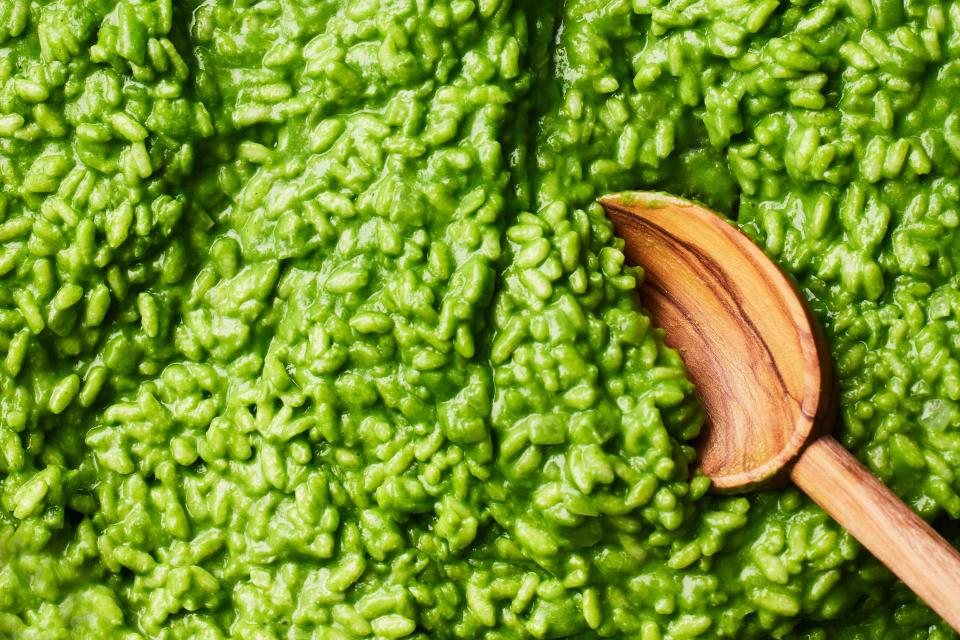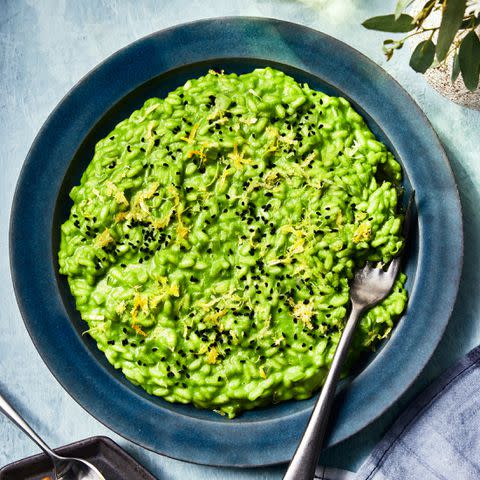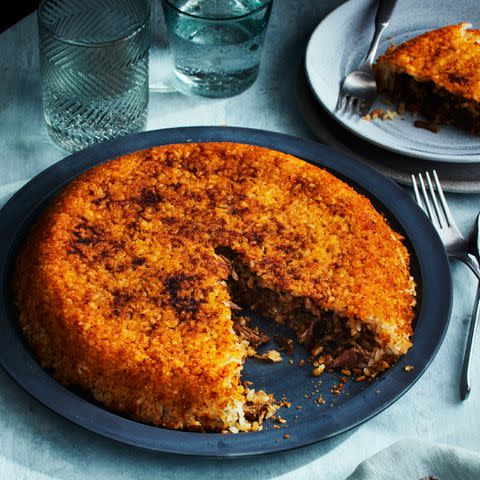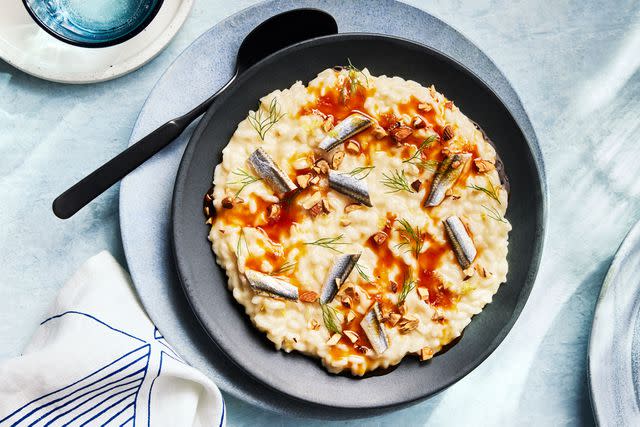Italian Chefs Are Reinventing Risotto, and It's More Delicious Than Ever
From Piedmont to Puglia, classic risotto is getting a refresh.

Greg Dupree / Food Styling by Ruth Blackburn / Prop Styling by Thom Driver
“All’onda” can mean two different things to an Italian.
To a surfer child of the Riviera, it evokes the swell of the sea. (Onda means “wave.”) To a northerner, all’onda speaks to the ideal texture of risotto—the individual rice grains should be al dente, yet bound together by a starchy, flavorful magma so creamy that a quick flick of the pot will stir up a few “waves.”
The number of people familiar with the terminologies and technicalities of risotto is destined to rise like the ocean’s tide as its popularity expands outside Lombardy, Piedmont, and Veneto, in Italy’s north. Thanks to new rice producers who are growing some incredible varieties and chefs who are finally thinking beyond classic risotto preparations, the dish is experiencing a true renaissance throughout Italy.
Rethinking the fundamentals of risotto
As in much of contemporary Italian cuisine, the risotto renaissance embraces greater simplicity and lightness. Where once stood pots filled to the brim with robust stocks, mounds of finely diced sofrito, and hunks of butter for finishing, today, some make risotto with no onion, toasting the grains directly in oil. Some cook it with a light vegetable broth or just plain water. Cesare Battisti of restaurant Ratanà, the godfather of Milanese risotto, sometimes uses a hay- and pollen-infused “tea.”
Another point of risotto reinvention is the mantecatura, the act of beating cold fat into warm starch for creaminess. Brothers Manuel and Christian Costardi are at the forefront of the new risotto movement. The menu at the family restaurant they run inside Hotel Cinzia, in the town of Vercelli, in Piedmont, features several different versions of risotto, each a perfect marriage of technique and their trademark playful spirit. (In a nod to Andy Warhol, they serve tomato risotto inside a look-alike Campbell’s soup can, a presentation suggested to them by the late food photographer Bob Noto.)
“You want to know how many alternatives to mantecatura there are? How much time do you have?” asks Manuel Costardi wryly. Thanks to the availability of quality rice with higher starch content, achieving a creamy texture without butter is possible. “For our risotto aglio olio e peperoncino, we use an olive oil that is first whipped, then frozen; for our red pepper risotto, we use a super-thick red pepper emulsion; for our pea risotto, we make a pea ‘mayonnaise’ with sunflower oil,” he says. The brothers always add their main flavoring halfway through cooking. “Rice is like a sponge: It absorbs everything you add to it, so if you want to preserve the colors and flavors of your condiments, don’t add them too early.”
Alice Delcourt, chef and owner of restaurant Erba Brusca in Milan, is one of the people expanding risotto’s reputation: “Risotto is one of the more traditional dishes, so there used to be a tight canon of what was allowed. At most, you had saffron, pumpkin, porcini, and Parmigiano. It didn’t have much complexity of flavor.” Now, she explains, people are using risotto much more like a blank canvas. “Because it’s creamy and doesn’t have that much taste on its own, I try to keep that sense of decadence but also to freshen it up with a mix of unexpected flavors, like spices or sour notes. This week, I made a risotto with smoked ricotta and fermented beets. Last week, we charred the trimmings of vegetables, blended them, and used the resulting powder to layer in flavors.”
Related:21 Risotto Recipes to Make Again and Again
Celebrating Italy's heirloom rice varieties
Many of this new guard of risotto makers print their favorite brands of rice on their menus—because there can’t be exceptional risotto without exceptional riso. Many things have changed on that front, too. “After a period of intensive agriculture and bulk, half-assed production, we have finally entered a more conscious era of rice handling,” says Battisti. “The product’s quality has increased, and people in turn understand how much richer in flavor and nutrients it is.”
Italy’s main rice varieties include carnaroli, arborio, and Vialone Nano. Risotto is commonly made with carnaroli (which chefs love for its starchy yet al dente grains) or arborio (which has large, creamy grains, though it doesn’t keep its bite as much as carnaroli). Vialone Nano works better for a soupy minestra di riso, like the Venetian risi e bisi (rice and peas). But the many nuances of the Italian rice palette don’t end here.
“Our country boasts an exceptional level of rice biodiversity, more than 120 varieties,” says Battisti. “Today, producers are once again growing some of the oldest ones, like Bertone, Rosa Marchetti, Dellarole, Baldo, Sant’Andrea—they’re not all fit for risotto, but they’re perfect for salads, soups, and desserts.” Behind chefs’ picks like Riserva San Massimo and Gli Aironi are young farmer entrepreneurs operating out of historic bastions of rice production— the Po and Ticino valleys, between Vercelli and Pavia, made famous by the immortal figure of the mondina, the seasonal rice weeder.
“My mother was a mondina,” says Dino Massignani, director of Riserva San Massimo, the main producer of authentic carnaroli in Italy. “There are several lesser varieties of carnaroli, which by law can all be labeled as carnaroli. I owe my mother my passion for the real one: It’s an elegant, tall, tricky plant, requiring expert handling,” he says.
Because of my own professional work with bread and wheat and passion for fieldwork, I decided to put on some heavy-duty boots and go and geek out on this production in person. Massignani was kind enough to accompany me for a day, chatting and driving me around in his pickup truck while occasionally stopping to point out a deer’s antlers peeking out from behind a tree or a heron taking flight.
Riserva San Massimo owns about 2,000 acres and grows rice on one-third of it; the rest is left to a stunning patchwork of ecosystems, densely populated by pheasant, geese, buzzards, ibis, and other species. “Can you see the water bubbling?” asks Massignani as he leans over one of 44 natural springs that irrigate his fields. Once harvested, the rice is dried at a low temperature and then slowly husked with a fine-grain stone—the equivalent of stone-milling good wheat. The farm has three goals: preserving healthy soil through sustainable agricultural practices, exploring the potential of rice and its flavor through the reintroduction of heirloom varieties, and combating rice’s boring reputation through clever and fun marketing.
I see a similar approach in Maremma, a part of southern Tuscany, where Tenuta San Carlo owns 1,200 acres of land producing certified-organic carnaroli (as well as less-creamy Ribe and a small experimental patch of sake rice). Walking through the fields—half of which are part of a nature reserve — with Ariane Lotti, great-granddaughter of the estate’s founder, Achille, Lotti describes their work with regenerative agriculture, a low-impact style of farming where the soil is left largely undisturbed and rice grows over a mulch. Equally inspiring are rice producers such as Rosalia Caimo Duc of Terre di Lomellina (one of the first to grow organic rice in Italy), Igiea Adami of Beni di Busonengo (her husband, Guido Zampaglione, is a well-known natural-wine producer), as well as the brothers behind Una Garlanda. What these growers remind me is that what we eat is always the result of a chain of people and products, and quality starts with the first link.
Related:Rice Is Everything
Bring the risotto renaissance home
Making risotto at home doesn’t have to be the culinary equivalent of a triple axel. As Manuel Costardi says, “The beauty of rice is that you can make it with whatever you want. It goes well with everything.” Remember, when it comes to risotto, the oldest rules of the genre were meant to be broken. Risotto with water? Yes. Risotto with no butter? Sure. Unconventional flavor pairings? Bring it on. This is your license to stir. Just don’t forget to have some fun with it. Here's how to get started.
Start fresh
You don’t have to toast your rice in fat and sofrito unless you want a decadent risotto. (In most cases, you won’t even be able to taste the sofrito at the end.) For fresher, brighter risotto, you can start by coating the bottom of your pot with a mild olive oil and toasting the grains until they’re translucent (or too hot to hold in the palm of your hand).
Just add wine
Some chefs use wine to deglaze the pot before starting to add the liquid; it can either go in right after the sofrito is cooked, if you’re using it, or once the grains are toasted. This addition imparts a pleasantly acidic note that brightens richer versions of the dish. Use a dry, nonaromatic white wine. (Red wine can be used, too, but only in hearty risotto like borlotti and sausage, which calls for a Barbera: Remember, it will impart not just flavor but also color to the grains.) Vinegar can also be used for acidity — just remember it’s more acidic than wine and therefore better to add at the end.
No broth, no problem
For super-light risotto, you don’t need a rich stock or chicken broth. (They’ll end up overpowering your main flavor.) Make a light vegetable broth or just use water. Keep adding the liquid a ladleful at a time but without overdoing it — you can always add, but you can’t take back.
Know the 13-minute rule
Good-quality carnaroli will cook in 13 minutes from the point you start adding the liquid. As you keep adding liquid and stirring, taste the rice. When it’s cooked but still quite al dente, turn the heat off. Some brands might take more or less time than what it says on the package; always test the texture and adjust accordingly.
Master mantecatura
Similar to other emulsions such as mayonnaise, this is the act of beating cold fat into the warm starch to produce a creamy result. If you are using cheese, use a less-aged Parmesan, as it will melt more easily into the rice, or choose a creamy cheese, such as robiola or a caprino, and beat it vigorously; incorporating air will also help get it to the ideal texture.
Give it a rest
Before the mantecatura stage, let the risotto sit, covered, for one full minute off the heat. This helps achieve the perfect texture as the last liquid settles and absorbs. It will also mean your risotto is not super hot when the cold butter hits, making it less likely to split.
Use the right rice
You can’t make risotto with long-grain rice (like basmati) or short-grain rice (like sushi or glutinous rice): not enough starch in the first, too much in the second. You want a medium-grain rice, preferably of the superfino category (the best). Stay away from packs bearing the generic “risotto rice” label. Instead, shop by variety.
When it comes to choosing one, arborio is the easiest to find. Arborio’s large grains yield very creamy risotto and can absorb lots of liquid, but with less bite. California-based brand Lundberg produces arborio rice available in many supermarkets. Vialone Nano, grown in Veneto, is stubby and thick and perfect for soupy risotto or minestre di riso.
But chefs will tell you carnaroli is their first choice because its plump, starchy grains hold up beautifully during cooking and deliver the ideal al dente bite. You can find a few Italian brands of carnaroli rice in the U.S. online through specialty retailers, such as Gli Aironi, Riserva San Massimo, Riso Buono, and Acquerello. Many supermarkets in the United States also carry carnaroli rice: Acquerello is available at Whole Foods, and Campanini brand carnaroli rice is available at Walmart and many other markets and specialty grocers, including Eataly.
Recipes
Risotto al Salto (Crispy Rice Pancake)

Greg Dupree / Food Styling by Ruth Blackburn / Prop Styling by Thom Driver
In this two-for-one recipe, you can make this saffron-stained, creamy yellow risotto that is perfectly delicious served all’onda (creamy and hot)—or prepare it al salto (fried) into crisp golden pancakes and topped with a bright fresh parsley and lemon zest gremolata.
Risotto with Parsley Puree and Caramelized Garlic

Greg Dupree / Food Styling by Ruth Blackburn / Prop Styling by Thom Driver
When making risotto, Alice Delcourt says simplicity is key. Let the flavors shine while the rice binds them into a creamy and, in this case, herbaceous dish. For leafy herbs like parsley, blanch and shock the greens before adding them to the hot rice in order to maintain their fresh flavor and vibrant color.
Bomba di Riso (Stuffed Rice Cake) with Shredded Duck

Greg Dupree / Food Styling by Ruth Blackburn / Prop Styling by Thom Driver
At the iconic restaurant Ostreria Fratelli Pavesi in Emilia-Romagna, the three Pavesi brothers pay homage to a mid-19th-century delicacy: the molded baked rice “bomb” stuffed with a hearty filling of shredded duck and earthy porcini mushrooms. While a traditional bomba is dome-shaped, we’ve opted for a deep nonstick skillet for easy unmolding.
Risotto with Boquerones and Fish Sauce Caramel

Greg Dupree / Food Styling by Ruth Blackburn / Prop Styling by Thom Driver
While the idea of a risotto studded with anchovies and fish sauce caramel might seem out of the box, this dish, rich with umami flavor from aged Parmigiano-Reggiano and colatura di alici, an Italian anchovy fish sauce, is pure elegance. At the restaurant, Giorgia Eugenia Goggi tops the risotto with homemade gravlax anchovies. We’ve opted for store-bought boquerones, white anchovies from Spain, for an equally satisfying garnish.
Tortine di Riso Agli Agrumi (Italian-style Rice Custard with Citrus)

Greg Dupree / Food Styling by Ruth Blackburn / Prop Styling by Thom Driver
This sweet rice dish from Tuscany-based cookbook author Emiko Davies (Cinnamon and Salt, 2022) has two distinct layers—a barely set baked custard top and a bottom layer of tender rice bound with custard. While not traditional, orange slices highlight the subtle citrus notes of the liqueur. Let tortine cool completely before brûléeing to prevent curdling.
For more Food & Wine news, make sure to sign up for our newsletter!
Read the original article on Food & Wine.

